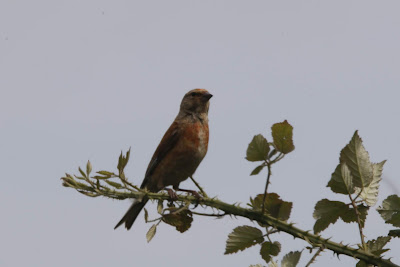Now I'm not going to be a cry baby, but whilst slugging around these reserves and seeing very little, places like Minsmere were having bumper wader days. This is the life of a birdwatcher and I shall shut up about it from now on.
This is the time of year for WADERS, with lots of birds turning up at the moment as they partake in the Autumn migration, a time when millions of birds are on the move. So I thought where better for seeing them than the scrape on Hollesley Marshes, what would seem the perfect habitat for those birds - lots of mud next to an estuary. Boy was I wrong. When I turned up the place was absolutely dried out, and had been for months - there were no birds what so ever!
There was very little to photograph, what birds that were around were distant in the hazy light, so plenty of pictures of cows - the only living things seen today!
Hollesley left me flummoxed, so with nothing to do I decided to walk along the river to Boyton Marshes. This is another small RSPB reserve just up the Alde estuary, and by taking the footpath along the river wall could arrive there in around thirty minutes. Along this route I passed a small Suffolk Wildlife Trust reserve called Simpson's Saltings, an area of saltmarsh and shingle bank, protected for its rare flowers, which was a nice bonus to find.
An area of intensive farmland separates the two reserves of Hollesley and Boyton, land I hope would eventually be bought up by the RSPB and used to create one giant reserve there. The grassy areas of the river wall were full of SKYLARKS and MEADOW PIPITS, as they raised young on these remote areas. The sun beamed down and I didn't see a soul...
The concrete block at the back of the picture is an anti-tank structure built when there was the very likely scenario that the Nazis would invade the UK in World War Two.
It was high tide on the estuary and there were few birds, the odd OYSTERCATCHER, CURLEW and some WHIMBREL. As the path went passed Havergate Island there were plenty of COMMON SANDPIPERS disturbed from the river wall, flying out with that strange jerky wing beats of theirs. There were plenty of TERNS flying along the river, both SANDWICH and COMMON, with juveniles, so maybe they have had a good breeding season, possibly at Havergate.
Boyton Marshes is a small RSPB reserve that's rented out as a farm, but with nature in mind, obviously. At this time of the year most of the wetlands had dried up and it was just cow grazed fields, so the number of birds was quite low. A male WHEATEAR was present at the start of the reserve, which is a very early date for this species, my earliest for Suffolk in Autumn. Unfortunately it wasn't the first in Suffolk this year, as one was recorded at Landguard the same day, at an earlier time.
There was one pool left at Boyton, where a couple of GODWIT, AVOCET and SHOVELLER dwelled. A WOOD SANDPIPER was seen briefly in flight, which was a bonus, something desperately needed on a day like this.
North Warren
With the long days of late Summer there was still plenty of time to do some more birdwatching, as I desperately sought to find some birds. Unfortunately I chose North Warren to search for birds and, well, I chose wrong.
Now North Warren is a great reserve, as in winter it holds thousands of birds, but on the last day of July there really wasn't a lot happening, a lazy hot day.
Everything was centred around the only remaining pool on the reserve, where I found two sleeping SPOONBILLS. When at the end of my visit I came back again one was out feeding, sieving through the water although the other one had disappeared. There were also several GODWITS, AVOCETS (as there is on every pool in coastal Suffolk), two GREEN SAND, and one GREENSHANK.
This habitat at North Warren is called wet grassland or grazing marsh, but at this time of year there is little flooding so it was just an area of dry rough grassland. The grassland is split in two by a footpath, and each of these areas have a herd of cattle that had free reign to graze where they want. This creates an uneven sward which is attractive to so many different species in winter and breeding birds in summer.
Running north of the grassland area is the disused railway line which is an area of young scrubby woodland. There was plenty of small bird flocks, but they were all local birds, so nothing unusual. I walked a lot of the reserve but after a fruitless search called it quits and ended the day's birdwatching.
As you can see today was hard work for very little. I haven't ever visited these reserves at this time of year and now I know why I never bothered. These reserves can be good, mainly in winter, they are very much wetlands and need water, which isn't around in any great quantity at this time of year.
I've been trying to broaden my horizons and not just rely on going to Minsmere, but Minsmere is the best reserve in the country and it holds the most birds at any time. Still August is upon us and this is the time for waders, so I shall search for that area of mud still remaining which will maybe entice down a nice flock. Here's to more birding adventures.






No comments:
Post a Comment